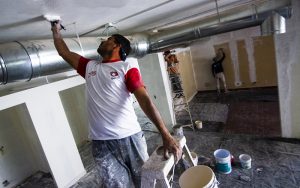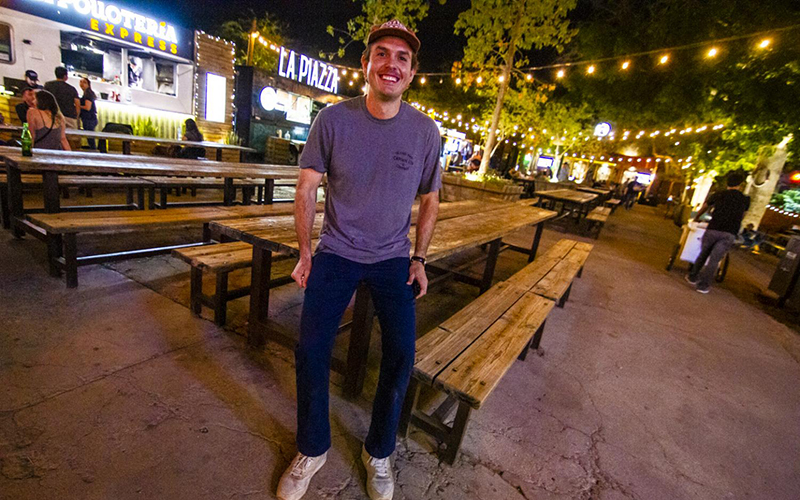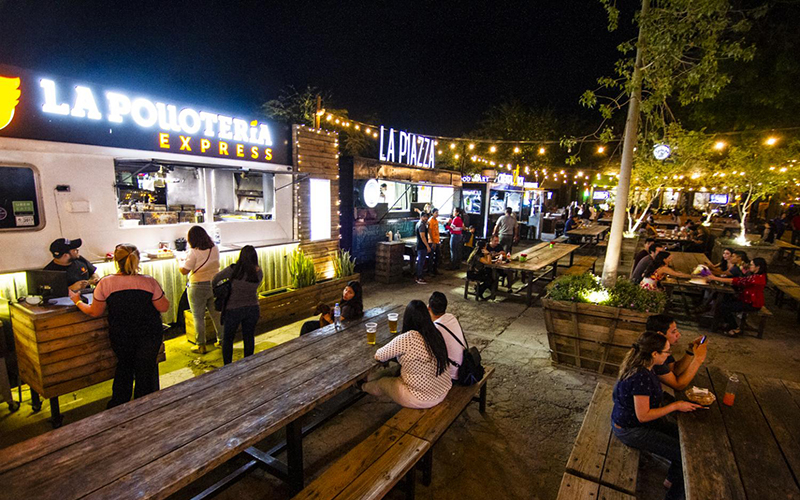HERMOSILLO, Mexico – In a spacious house in downtown Hermosillo a few weeks back, workers were scraping old paint from the walls, getting them ready for a fresh coat.
The property is at the tail-end of a transition from a family home to a coworking space, one that also will feature a salon, rooftop common area, tree-shaded patio and other amenities.
“So we’re standing right in what’s going to be the coffee shop,” said Jim Britton, a Canadian whose family’s drilling business brought him to Mexico for the first time in the early 1990s. “It’s going to be inhabited by a coffee shop called Cafe Catrin, which does in my opinion here in the city a great job of making coffee.”
After moving to Mexico more than two decades ago, Britton fell in love, started a family and eventually returned to Canada, only to have to Mexico pull him back a few years ago. Now he’s one of the backers of two major redevelopment projects along Boulevard Hidalgo that hint at a renewed interest in the Sonoran capital’s urban core.
“It’s becoming this area where you have a whole bunch of services basically under one roof, one roof being the neighborhood,” he said. “We’re hoping that it just starts building, and growing and pretty soon that this area becomes a destination.”
A stone’s throw from the house is a brand new beer garden with an expansive menu of Mexican microbrews. A bit farther is a soon-to-open boutique hotel. Some of Hermosillo’s best restaurants are a short walk away, and a tree-lined pathway stretches east to Hermosillo’s charming main plaza.
Mixed in with the newer, higher-end spots are places like Melas, an affordable hole-in-the-wall with must-try renditions of Sonoran culinary standards.
“It will be a zone hopefully that will be accessible to everyone in this city, and anyone who’s visiting us,” Britton said.
Like many North American cities, Hermosillo’s urban footprint is experiencing dramatic growth. In less than three decades, it more than doubled to roughly 70 square miles, and its rate of growth is now faster than the underlying population, according to a recent planning document.
“That obviously brings serious sustainability consequences for the city,” said Guadalupe Peñúñuri, head of the municipal planning body. “Revenues have grown much more modestly than the urban footprint.”
Outward expansion has also meant greater car dependency, and a hollowing out of the center, she said.
But alternative approaches to growth – like taking advantage of existing low-density within the footprint – are gaining traction. Hermosillo recently developed a revitalization plan for a large swath of the city’s historic center.

Painters work to convert a family home into a coworking space in Hermosillo’s center. (Photo by Murphy Woodhouse/KJZZ)
“The idea is to rehabilitate the center, and come to see it as not just a place for business, but as a place to live, a place to work, a place for innovation and creativity,” Peñúñuri said.
There’s talk of a student housing complex and a senior living center. Also on the table are incentives for developers, more flexible zoning, investment in public spaces and the promotion of non-motorized transportation, according to Peñúñuri and a municipal planning document.
While the city works on implementing its plan, private projects are forging ahead. Perhaps the best known is Parque la Ruina, a food-truck hub and music venue, among other things.
Its name – Ruin Park – comes from the long abandoned textile factory that used to occupy part of the expansive property.
Jose Luis Deschamps, one of the park’s young founders, was there getting dinner on a recent weekday evening. A wireless buzzer told him his regular taco caramelo and a light version of the same thing were ready.
“I’m on a diet, man,” he noted.
In just a few years, La Ruina has become a local favorite. Free dance classes, movie screenings, music festivals and diverse food options draw consistent crowds.
“What we’re trying to do is build our own city,” Deschamps said. “Like build the city in which we would like to live.”
And for Deschamps, that means a city with a denser core, where getting together for food, fun or business doesn’t mean a long drive through traffic snarls. The success of La Ruina has sparked other developments in a previously overlooked area near the city center.
“People (are) looking for … this kind of places,” Deschamps said. “There should be more places like this. I mean, different kinds, but if you build these places and the city around it, it gets people to live better.”
At Plaza Londres, Britton’s other project on Boulevard Hidalgo, cafe customers are working and chatting in the outdoor seating area. A stately former mansion now features several shops, a small crepe restaurant and spaces for yoga and meditation classes. Several Arizona State University students and staff members are slated to be the first guests in the second-story Airbnb units.
“I think there’s been a resurgence of young people, kids our age, from 18 to 30 years old, where we’re looking for more places like this in the center,” said Zaid Olivarria, a freelance graphic designer.
But the new shops, cafes and restaurants also drew Jonathon Bell, owner of Dynapro, a mining pump manufacturer that will be based at Britton’s coworking space. Having legal and accounting businesses they work with nearby also was a plus.
“This is the area that we felt was the best, with the development that’s happening here in the center of the city,” he said. “So it’s kind of in the center of everything for us here.”
He added that he and his employees are able to walk everywhere they need to go. They even from time to time hold what he calls “walking meetings.”
“It’s just nice walking around the center of Hermosillo,” he said. “It’s a really nice area.”
Follow us on Twitter.
AlertMe


